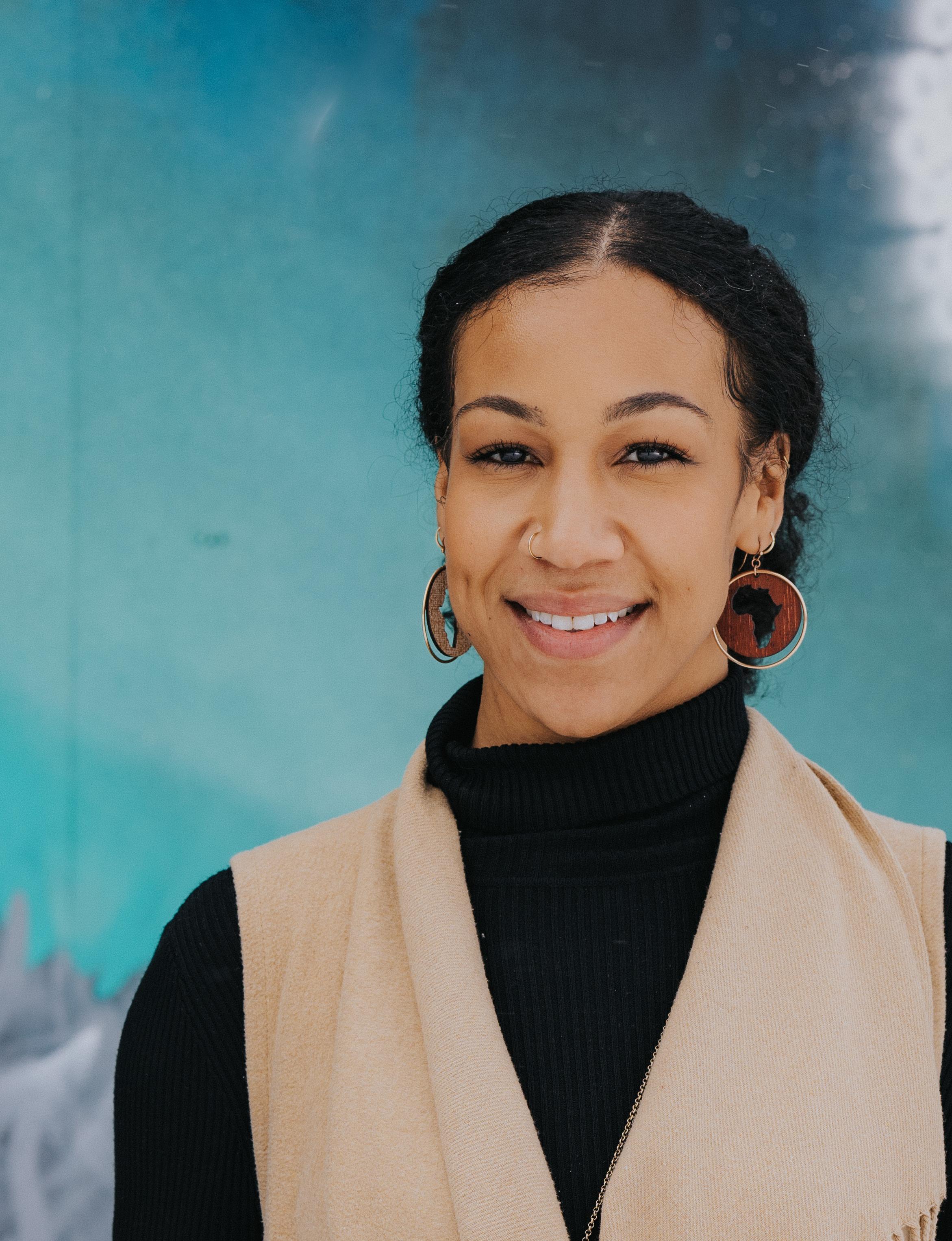








WINTER 2022 | VOLUME 89, NO. 2 PAGE 8 LEADING CHANGE
PAGE 4 CLASS SIZE & COMPLEXITY SERIES A pervasive symptom of chronic underfunding in public education PAGE 10 BARGAINING 2023 Key themes and next steps +
Regina teacher Keilyn Howie leads the way in anti-racism work

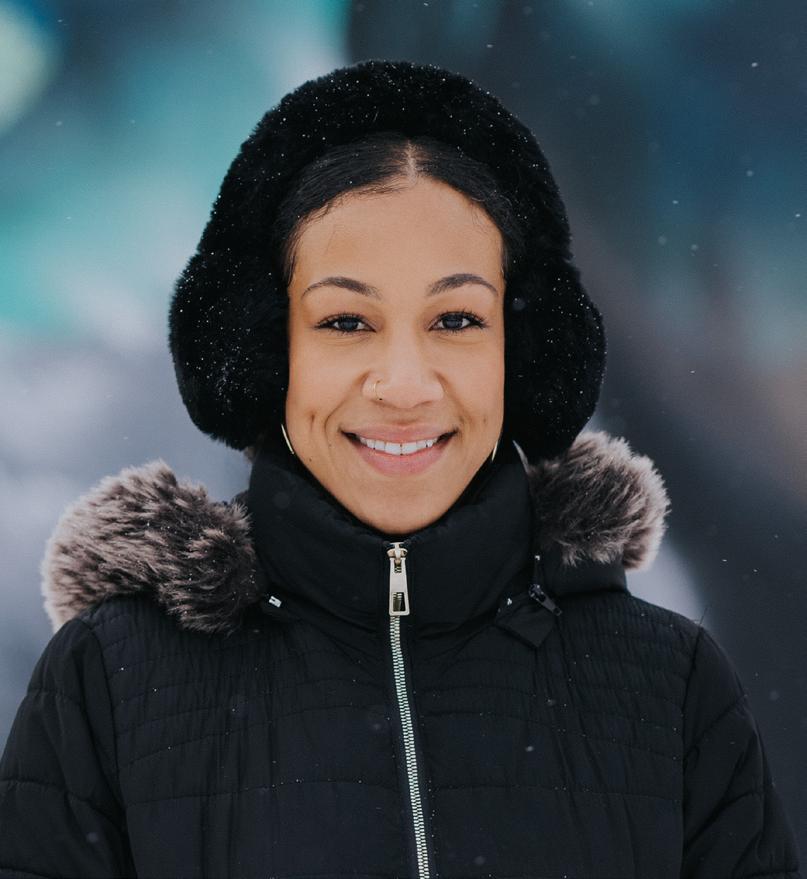
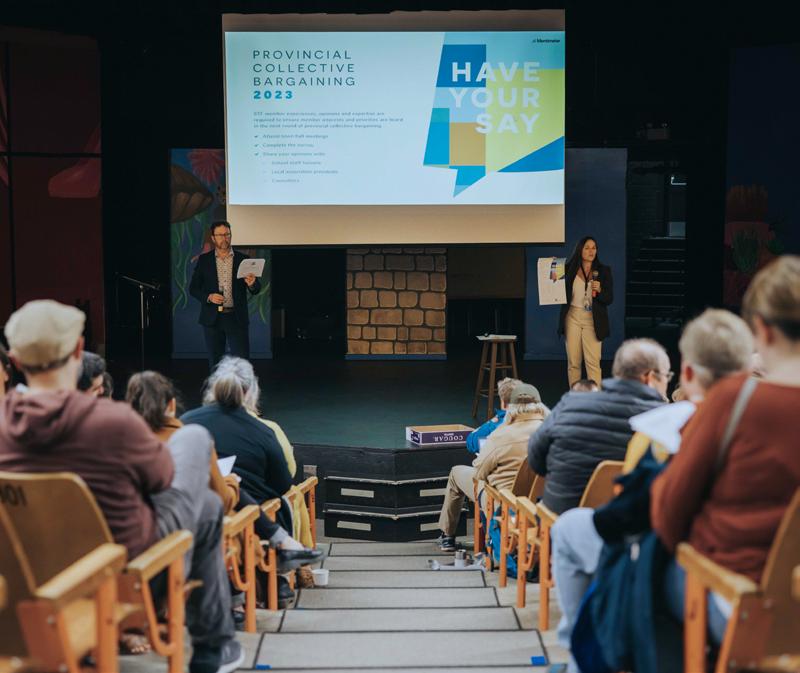
WINTER 2022 | VOLUME 89, NO. 2 ISSN 2816-3885 (Print) ISSN 2816-3893 (Digital) The Saskatchewan Teachers’ Federation Bulletin is published four times during the school year and is distributed both electronically and in print. Have a story idea or a topic you would like us to include? We’d love to hear from you. Reach us at stfcommunications@stf.sk.ca For our current advertising rate card or to book an advertisement, please contact stfcommunications@stf.sk.ca Editor: Courtney Forseth, Managing Director of Communications and Public Relations www.stf.sk.ca @SaskTeachersFed ©20 22 . For permission to reprint, please contact the editorial office. Indexed in the Canadian Education Index ISSN 0036‑4886. Member of the Canadian Educational Press Association and the Educational Press Association of America. Cover image: Brittany Bellamy Table of Contents President’s Update 3 Advocacy – Different but the Same Ad Resonates With Audience 7 For You and Your Family – Your New Health and Dental Provider 11 Being Called In: Advancing Inclusion, Diversity and Human Rights 12 In the Classroom – Overwhelmed With Documentation? 14 Upcoming Events 16 Reconciliation in Action –STF Walks the Path to Reconciliation 18 The Changing Face of Education –Alternate School Year and School Day 20 The Makings of a Provincial Budget 22 Collective Wisdom – Teacher Wishes for Students in 2023 24 Meet Your Local Leaders 26 Record Enrolment in Saskatchewan Schools 29 Inflation, Interest Rates Continue to Rise 29 Principals’ Notes – Advice for Navigating Device Use and Privacy Protection 30 SERIES TEACHERS INSPIRE WORKING FOR YOU 4 8 10 Class Size and Complexity Regina Teacher Leads the Way in Anti-Racism Your NEW Bulletin Is there something you like, want more of or want us to change about the Bulletin? Complete this two minute survey to let us know here Bargaining Consultations Reveal Key Themes
Overthe last six months, I have had the privilege of travelling the province to meet with teachers in their home communities and I am constantly struck by the commitment of Saskatchewan teachers. The province’s 2022 23 budget forced school divisions to make difficult decisions and cut programs, services and staff. While the Government of Saskatchewan has since announced additional funding, it only addressed transportation costs and record high enrolment. In the face of ongoing chronic underfunding, you continue to do incredible work with limited resources. No matter the location of the community or the population of the school, teachers and principals are struggling to fully meet student needs due to a lack of resources. More and more, I am hearing the word “triage.”
Teachers can’t and shouldn’t be expected to continue to do more with even less. This message came through consistently – whether at bargaining town halls, Councillor Conference or local association meetings. For too long, teachers’ compassion and ingenuity has meant that we have just always found a way to make it work. But at some point, you can’t plug the hole in the boat any longer and it starts to take on water. As we prepare for provincial collective bargaining to start in the spring, it is evident that action on class complexity is an urgent need. While disheartening, this is not surprising. These challenges aren’t new; they have only been compounded by new pressures and haven’t been addressed.
I want to extend my appreciation to each and every one of you who took the time to send an email, complete the survey, or attend a town hall, forum or focus group. The level of participation and engagement has been extraordinary and demonstrates how strong our collective is. The next round of bargaining is anticipated to be difficult. Staying connected to one another and committed to our common goals will be key to our success. Reflecting on CUPE education workers’ recent experience in Ontario is a timely reminder of the power and influence we can have when we come together.
If you didn’t have a chance to join an engagement session, there’s still time. In early 2023 additional town halls will be held and we will also continue to collect stories of real classroom experiences to describe how chronic underfunding is impacting Saskatchewan children each day. You can email your experience to us at advocacy@stf.sk.ca.

I wish you all a restful December break and look forward to working together in 2023.
Samantha Becotte President, Saskatchewan Teachers’ Federation

PRESIDENT’S UPDATE
3
BRITTANY BELLAMY
SERIES & CLASS SIZE Complexity
Class size and complexity challenges exist in classrooms in every corner of the province. In a series of articles in the Saskatchewan Teachers' Federation Bulletin, we will share stories from Saskatchewan teachers as we explore how significant the challenges are and the impact on students’ educational experiences and the teaching profession.
BY STAFF WRITER
The concept of complex classrooms and how teaching continues to intensify was present more than 20 years ago, back in 2001 when the SchoolPLUS report came out. Since then, challenges have only evolved and become more prevalent – with no commitment to solutions from the provincial government.
The significance of the issue led teachers to rate class size and complexity as the top priority, along with salary, in negotiations for the 2019-2023 Provincial Collective Bargaining Agreement. It is arguably the number one issue which educators confront as part of their daily routine, along with an ever shrinking support system, increasing enrolment numbers, and assorted other challenges that students and teachers alike are grappling with daily.
Since 2019, the challenges have only increased – growing enrolment, larger class sizes, and more complex and diverse needs amongst students. Add in a global pandemic, which led to significant interruptions to learning, and provincial funding that has not kept up with costs, and you have a recipe for a system that is not functioning as intended. Teachers are burning out and the profession looks less appealing, setting the stage for recruiting difficulties and future shortages. Students’ education is suffering.
Teacher and student experiences with class complexity may look different from school to school, but very quickly common themes begin to emerge. At its core, class size and complexity is about the composition of a class and the professionals that are available to support that class.

As you read just a small sampling of the experiences of teacher colleagues from throughout the province, there is every chance the scenario is not dissimilar to the one you too are experiencing personally.
A teacher from a medium sized school division shares that her classroom has 27 students; three are on individual learning plans and seven are on records of adaptations. There is only one educational assistant to support, and that EA is dedicated to one student. The result?
“Most students teach themselves as I assist the nine who require more assistance … [It’s] constant survival mode.”
Even if the number of students in the class isn’t large, complexity and composition challenges are still ever present, as portrayed by this teacher of a class of 21 students.
“A triple-grade classroom that includes one student who can neither read nor write and has no EA … A math class with Grades 3, 6, 7 and 8 curriculum.” It’s a situation that is difficult for everyone.
Long time educator Andrea* shares a harrowing experience that could play out virtually anywhere. Andrea teaches in a community that would be considered a medium sized Saskatchewan city. She recalls all too vividly a pair of what she called “very scary” incidents in which a student physically attacked fellow students and staff members.
... challenges have only evolved and become more prevalent – with no commitment to solutions from the provincial government.
4
According to Andrea, this situation could have been avoided if the student had access to appropriate support. The student’s inability to contain their temper was due in large part to the lack of trained staff available to support students.
She recalls having to close the door to her classroom. As one who has always stressed the importance of forging relationships and trust with students, she calls the plight of teachers in today's environment as,
“you feel powerless when a situation like this occurs.”
The inclusion model is grossly underfunded to the degree that there is far less, or virtually no, access to specialists such as psychologists, which is to the detriment of everyone in the classroom.
“It is absolutely getting worse and the inclusive model we have striven for is no longer working due to lack of funding,” she offers.
A Working Committee on Classroom Complexity and Inclusive Learning Environments was established by the
Saskatchewan Teachers’ Federation and included STF staff members as well as 14 teachers from throughout the province. The fact there were 70 applicants for this one Committee tells its own story loud and clear.
Included in the discussions were issues such as multigrade classrooms, intensive or special needs students, student discipline and eroding or non existent student and teacher support, as well as mental health concerns. Following a series of meetings, which included some complicated discussions about the realities of the classroom, the Committee came to a unanimous conclusion: the only solution is a fully funded inclusive learning environment.
One of the more poignant sketches that came from these meetings was entitled Tape + Bubble Gum: Making it Work.
It sums up what teachers have always done – including the always important establishing of relationships, teaching social and emotional skills to students, and the importance of culture and belonging as a way of making it work for students.

5
VISUAL RECORDING OF MAY 2022 CCILE MEETING
However, against that backdrop was the darker reality of teachers having to triage while acknowledging not everyone’s needs can be met in the same way under the current circumstances, including the reality that funding is not sufficient to support inclusive classrooms. There were shared stories of picking up students for school, while at the same time facing a diminishing amount of personal time to create resources.
These stories are not limited to those who sat on the CCILE Committee. The Federation has invited teachers to share their experiences, and the responses received show this is a prevalent issue that exists in every corner of the province, in all communities.
“we lost a lot of ground with many [students] both academically and mental health wise.”
Melissa*, a teacher with 24 years’ experience in an urban setting, shared her reality of having a class of 27, more than half of whom have diverse learning needs, including academic learning delays, intense behaviour, and many who are English as an additional language learners as well as those students who simply have undiagnosed medical needs – all this in a split-class environment.
“We are offering a second-rate education because of the lack of money and supports.”
Or here’s another stark assessment from a long time educator, Nathan*:
“In my career, this is the worst that conditions have been for learning and teaching.”
Andrea echoed those sentiments, while stressing that she considers herself a pretty resilient person who loves what she does, “but I can't handle the shifting environment and we've had very frank discussions in my classroom; but there are many factors, all which lead to a vibe that I have never felt.
“I feel depleted when I come home, and we just don’t have the tools in place to handle these challenges. You can’t have the collaborative approach you need or attention to wellness. The system currently is broken.”
Some of the contributions offered by teachers include those who have been in the profession for as many as 37 years, which Linda* attributes to her love and passion for being a teacher. However, she raised the issue of her safety concerns. She cited an example whereby three students who require one-on-one assistance have had to be integrated into a regular classroom with no extra supports.
Juanita*, from a school division in southern Saskatchewan, noted the lack of available substitute teachers as another major concern. She alluded to a survey done by the students last year, which identified the reality of mental health issues and the frequently shifting modes of delivering education that was required. As Juanita laments,
Andrea also stresses the need for parents to have their voice heard among the politicians. Although in her view, parents are often blissfully unaware of the reality of the shortcomings faced in today’s education system and so students are susceptible to falling through the cracks.
The specifics might change geographically, but there is no debate that these are concerns that have only been exacerbated by chronic underfunding of education by the provincial government. If you ask teachers, arguably the professionals who are the pre eminent experts on the issue, they will offer solutions grounded in their professional experience and training. “It isn’t just about class size; student needs must be considered and provided for,” offers Chris*
*Pseudonyms have been used to protect the privacy of teachers and students, but the stories are all real and recent experiences shared by current STF members.

The specifics might change geographically, but there is no debate that these are concerns that have only been exacerbated by chronic underfunding of education by the provincial government.
CCILE WORKING GROUP MEETS AT STF 6
Different but the Same Ad Resonates With Audience
BY COURTNEY FORSETH, STF COMMUNICATIONS
In September, the Saskatchewan Teachers’ Federation launched a new commercial called Different but the Same. The ad highlights the different needs and strengths students bring to school each day. It reminds viewers that teachers want what is best for students and share the same aspirations as parents do. The ad also calls on the government to fund education so all students can thrive.
The goal of this ad is to start a public conversation about the impact of chronic underfunding on students.
The ad reached viewers on Saskatchewan television stations, social media and through digital ads. Across all platforms, the ad outperformed standard benchmarks.

HOW TEACHER VOICE CAN HELP
As a teacher, you are uniquely positioned to help government, parents and other decision makers understand the current reality in schools throughout the province. We know Saskatchewan schools are a great place for students to learn and they are made great by staff that continue to do more and more with even less each year.

Let friends, families and neighbours know about the challenges you and students face each day. As always, be sure to respect privacy and confidentiality.
Since launching the ad, we have received hundreds of stories from parents and teachers. Your lived experience matters. Help us tell your story. Share it with us at advocacy@stf.sk.ca
PARENTS AND TEACHERS ARE WORKING TOGETHER FOR OUR KIDS
WANT TO WATCH AND SHARE THE AD?
Find it on STF’s YouTube channel.
ADVOCACY
7
Regina Teacher Leads the Way in Anti-Racism

 BY STAFF WRITER
BY STAFF WRITER

For Keilyn Howie, talking about anti racism comes naturally. As a Black woman, she has seen and experienced racism her whole life. That’s exactly why she makes anti racism work a central part of her teaching career. “I can’t help but frame everything I do through that lens of anti racism. And to some people, it might seem a little bit different, or even radical, but for me, it’s just me being myself,” Howie says.
Howie teaches Grades 1 and 2 at Thomson Community School in Regina. “Even at that young age, they’re aware, and they see differences,” Howie says. For her, that setting is a perfect place to start conversations that are age appropriate about diversity. “I love when kids compare their skin colour to mine, or say that my auntie looks like you, and are proud to be who they are. That’s something that I love to do, and I love to give these kids that security in their own identities and their differences.”
TEACHERS INSPIRE BRITTANY BELLAMY 8
... it might seem a little bit different, or even radical, but for me, it’s just me being myself.
In the aftermath of the murder of George Floyd in the United States in 2020, Howie drew inspiration from her students and other youth. Students and communities circulated a petition calling on provincial curriculum changes to include more Black history. “It just makes you so proud to know that these young people are standing up for what’s right. Even for myself, it wasn’t really until I started thinking about how we can immerse Black voices into our curriculum that I even really began to understand how absent the Black Canadian identity was from our history books.”
This experience was a turning point for Howie, which spurred her to become more involved in making change. She now sits on Regina Public Schools Diversity Steering Committee, as well as on an anti racist, anti oppressive advisory committee, and with the University of Regina as part of a racialized graduate student committee. She has also been asked to contribute her expertise to a working group for Black identities and cultures with the Ministry of Education this past summer.
“I just really try to be a voice in as many groups as I can, because I realized how absent that voice is, and there are not a lot of Black teachers here in Saskatchewan.”


When it comes to talking about anti racism, Howie sees herself not just as a role model for her students, but for her fellow teachers as well. She offers herself up as a resource for those who may not have realized what privilege looks like. “I’m not just here for the students. I’m here for my co workers and my colleagues. I want them to feel comfortable
asking me questions because that shows me that they’re trying,” she says.
“I remind them the biggest mistake you can make is just not having these conversations at all,” she says. She’s far more concerned that sensitive topics might be avoided and encourages teachers to seek out anti racist resources if they have not yet integrated these learning tools into their classrooms.

It took a series of events and experiences for Howie to eventually pursue her Bachelor of Education. Her brother has Autism, and his experiences meant the field of education was always on her radar. A chance encounter with a customer, who happened to a Black professor, added some additional inspiration.
“She said to me, ‘you would make a really great teacher.’ And that was the first time I’d ever heard that,” Howie says.
She went on to work at the Autism Resource Centre and then as an educational assistant. One of the teachers she worked alongside as an EA gave her some additional encouragement. All these experiences combined lead to her completing her Bachelor of Education at the University of Regina in 2019.
“I always think about how it took a Black teacher to make me a Black teacher. And I just think that’s so powerful. I want to be that to students who might not see themselves represented.”
That conversation is one Howie remains thankful for. It has helped her find her passion in a professional career where she is serving as a role model for students of diverse backgrounds. “I get to inspire them and encourage them to dream big and pursue whatever they might want to pursue. I hope I can plant that seed in them the way that it was planted in me and that I can guide them towards believing in themselves.”
9
Bargaining Consultations Reveal Key Themes
BY STAFF WRITER
Member engagement and feedback through the entire provincial collective bargaining process is imperative. From gathering the initial themes that are important to members, all the way through to eventual ratification of a new collective agreement, member input is vital and the cornerstone of a successful process and outcome.
As the Saskatchewan Teachers’ Federation prepares for the start of the next round of provincial collective bargaining in May, feedback has been gathered from thousands of members through the bargaining priorities survey, focus groups, town halls and more.

A few key themes have emerged:
CLASS SIZE AND COMPOSITION
• One of the top priorities in the last round of bargaining – this issue still hasn’t been addressed.
• The last round of bargaining resulted in the Minister of Education (then Honourable Gordon Wyant) creating a provincial committee to study the issue. The University of Saskatchewan and University of Regina are conducting research and will provide a report to the committee.
• To date, no recommendations have been made or implemented.
• Since the last round, increasing class sizes, more complex student needs, and funding cuts have further exasperated the challenges associated with class complexity.
SALARY
• Teachers are feeling the economic pressures of rising inflation and interest rates.
• Maintaining purchasing power through salary increases is a top priority.
Other issues of collective concern are also emerging, such as supports for substitute teachers, defining the role of principals and vice principals, and ensuring the health plan includes adequate supports for mental health and rising costs of accessing health care practitioners.
HAVE YOUR SAY
What Happens Next?
JANUARY
Draft bargaining proposal package is prepared and shared with the STF Executive for feedback.
JANUARY AND FEBRUARY
Member engagement sessions to discuss strategy and refine the draft proposals.
Visit the Events Calendar in the new year for more information and to register for these events.
APRIL
Council will vote on the contents of the proposal package for provincial collective bargaining.
MAY Bargaining begins.
WORKING FOR YOU
10
Meet Your New Health and Dental Provider: Green Shield Canada
BY STAFF WRITER
1
MORE CONVENIENT ACCESS TO YOUR BENEFITS.
One app, one login and one ID for your health and dental benefits.
2 GET YOUR CLAIMS REIMBURSED QUICKER.
All claims submitted electronically will be processed within two business days.
3 YOUR BENEFITS AREN’T CHANGING.
Starting January 1, 2023, Green Shield Canada is the new insurance carrier. You’ll still enjoy all the same benefits.
4
SAVING MONEY.
The Saskatchewan Teachers’ Federation worked with the Teachers’ Superannuation Commission in a review and selection process. The move to a single carrier for both organizations’ carriers will result in significant reduction in administrative costs thanks to increased efficiency and economy of scale.
5 MORE DIGITAL TOOLS.
Access GSC everywhere, a website and app for benefits management on the go; the Change4Life health management portal; and the Digital Clinic, which points you to reliable health and dental care options.

6
EVERYTHING YOU NEED TO GET STARTED IS IN YOUR DIGITAL WELCOME KIT.
Check your email for your kit from GSC in December for your member ID and registration information.
7
STF AND TSC ARE STILL HERE TO ANSWER YOUR QUESTIONS.
We’ve changed carriers, but plan administrators haven’t changed. Contact the STF for health plan questions, and contact the TSC for dental plan questions.
8
GSC IS CANADA’S ONLY NATIONAL NOT-FOR-PROFIT CARRIER.
In 2021, GSC became certified as an Imagine Canada Caring Company for its community investments.

FOR YOU AND YOUR FAMILY
11
Being Called In: Advancing Inclusion, Diversity and Human Rights
 BY STAFF WRITER
BY STAFF WRITER
It was 2010 when the groundwork began for the Saskatchewan Teachers’ Federation’s Social Justice, Inclusion and Equity Committee and the work that would follow. That year, a Special Meeting of Council initiated a social justice and equity policy renewal process and, in 2018, a working committee of teachers was tasked to make recommendations for the renewed policies’ actualization. The committee presented 32 multi part recommendations, one of which was to create an internal committee of Federation staff to support the actualizing of the recommendations. This internal committee was approved and struck in October 2020, to be continued by the SJIE Committee, now the Inclusion, Diversity and Human Rights Committee.
Fast forward to 2022, and “the work now has its feet underneath it,” says STF Senior Administrative Staff Elizabeth Hutton Kristiansen. “We now have portfolio assignments that rest with senior administrative staff, which is new this year. Amending our title to Inclusion, Diversity and Human Rights instead of Social Justice, Inclusion and Equity was really important to our Committee because it really starts with that human rights lens,” she says.
Hutton Kristiansen has oversight of the Queer Identity portfolio. She collaborates with teachers, researchers, external partners and Federation staff to move all of this work forward. One way she does that is by sharing her identity and lived experience.
“I can be an ally, but sharing with teachers that I am more than an ally and I’m a member in the rainbow community –that's powerful for the membership, because then hopefully they feel affirmed and seen,” she says, adding, “teachers and, by extension, children should feel safe, included, affirmed and welcomed for who they are, period, in both schools and school communities.”
BUT HOW DO WE GET THERE?
“It’s really important for us to get comfortable with being uncomfortable and having conversations about
race and racism,” says STF Senior Administrative Staff Helen Vangool. Vangool leads the Anti Racism and Black, Indigenous and People of Color, or BIPOC, initiatives portfolio. A Black woman born and raised in Saskatchewan, Vangool says she was often the only visible person of colour in her classrooms.
“When I would experience racism, I didn't really understand it, and I thought there was something wrong with me. It wasn’t until I was much older that I realized there was something wrong with the system,” she says.
That’s what Hutton Kristiansen, Vangool, and new STF Senior Administrative Staff Angela Caron are all working hard to change.
A Métis woman from the Round Prairie Michif community, Caron is excited to be leading the First Nations, Métis and Inuit initiatives strand. For her, a lot of this work is about supporting those professionals on the ground, who are often a team of one.
“I want these teachers to know they are actually part of a larger team of educators who are focused on First Nations, Métis and Inuit initiatives,” says Caron. “Bringing these teachers together from across the province not only provides valuable learning opportunities, but it also creates a network of colleagues they can rely on for resources, encouragement and empowerment to continue doing this work in their communities.”
Vangool echoes this sentiment. “I think part of the work is to bring non racialized teachers along with us. It’s about deepening that understanding together,” she says. The other part is lifting up the voices of members who are racialized or identify as 2SLGBTQ+. “Their voices matter; their experiences matter. And the Federation cares about them and their experiences and wants to hear what they have to say.”
At the end of the day, this work requires a personal commitment from all educators, to learning and to
12
action. And while the fear of making a misstep is common, Vangool offers some sage advice: “If someone tells you that you made a mistake, they’re not calling you out – they’re calling you IN. They are inviting you to have a conversation to help deepen your understanding and awareness of the impact your words and actions can have on others. It is a move towards creating a more inclusive environment for everyone.”
WHERE DO WE START?
• Acknowledge. We each must acknowledge our own biases, racist thoughts and beliefs.
• Be comfortable with being uncomfortable. This work requires discomfort, and that’s OK.
• Do your research. Start reading and learning. Don’t rely on your Indigenous, racialized and 2SLGBTQ+ colleagues to educate you.
• Examine your interactions with others. Reflect on experiences you’ve had and how you’ve responded. Are there any behaviours that need to change?
• Own your mistakes, apologize and move forward. If someone tells you that you made a mistake, don’t take it personally. It’s the action they’re addressing, not the person behind it.
SAFM provides alternate formats (braille, large print, audio and e-text) for students in Saskatchewan who have a visual impairment, physical disability or learning disability that prevents them from accessing regular text.

WEB saskatoonpublicschools.ca/SAFM EMAIL AFMrequests@spsd.sk.ca
E levate your career with the EdD in Educational Leadership
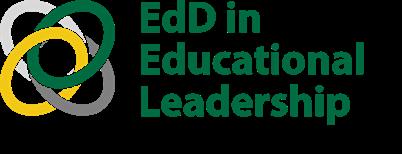
This professional doctorate equips educators with the insight, tools and wisdom to impact lives and create thriving communities.

Apply by January 15 to join a cohort of peers in this three-year, blended-format program. Course delivery begins August 2023.
grad.usask.ca/education
SASKATCHEWAN ALTERNATE FORMAT Materials Library operated by Saskatoon Public Schools
13
Overwhelmed With Documentation? Learn Some Simple Solutions
 BY STAFF WRITER
BY STAFF WRITER
Educators all know the critical role documentation plays in student success and improving learning outcomes – it provides valuable information for teachers, students and families about student progress and achievement. But how do you manage the hundreds of sticky notes, photos, products and more collected for documentation to support your assessment of each student and those learning outcomes?
Saskatchewan Teachers' Federation Professional Learning has developed Simple Solutions for Documentation, a course designed to deepen your understanding of the purposes of documentation, explore ways to manage and organize what you collect to connect to curricular outcomes, and support co creating criteria for quality documentation with your peers.
Whatever the purpose, understanding the audience and the “why” is critical for effective documentation.
“As educators, we want to have balanced documentation data among products, observations and conversations, and then look to triangulate that data. We also need to look at the tools we’re using – which tool fits the type of documentation best, whether it’s observations, conversations, or products,” says STFPL Associate Director
Connie Molnar. Teachers recognize their responsibility to collect and manage documentation – for many purposes, such as to demonstrate developmental progress, show accountability, make learning visible, support conversations with parents and families about a student’s progress. Whatever the purpose, understanding the audience and the “why” is critical for effective documentation.
“A lot of the day is exploring all the different tools that you might use, depending on your purpose and audiences,” Molnar says. But just as important, the course is an opportunity to create networks of support and learn collaboratively with peers.

“Teachers are highly skilled professionals and they have a lot of knowledge, so we purposely design our sessions to allow that knowledge to be shared and for networking, with the intention of creating a system of support in the room,” says Molnar.
Quick Tips
1
UNDERSTAND YOUR PURPOSE AND YOUR AUDIENCE. Why are you collecting the documentation, for whom, and what learning or planning outcomes will the products, observations or conversations serve?
2
DETERMINE THE BEST TOOLS TO USE. Consider whether the documentation is for working with an individual child, for yourself to help you plan forward for the next lessons, for assessment, or for a student’s parents or family.
3
COLLECT ONLY WHAT YOU NEED. Ask yourself, “am I collecting just enough information for my purpose and audience and not more?” This is important for data privacy but also helps you focus and avoid becoming overwhelmed.
SHARE
4
KNOWLEDGE AND
BEST PRACTICES. Build and lean on your networks so you and others in your field can mutually support one another.
IN THE CLASSROOM 14
DOCUMENTING LEARNING: RESOURCES AVAILABLE FROM THE EMMA STEWART RESOURCES CENTRE
Collecting Evidence and Portfolios: Engaging Students in Pedagogical Documentation
Authors Anne Davies, Sandra Herbst and Brenda Augusta explain how to deeply involve students in collecting evidence of their learning in this practical, concise guide. Examples of how to create collections of evidence and portfolios for elementary, middle and secondary students are included.

A Guide to Documenting Learning: Making Thinking Visible, Meaningful, Shareable, and Amplified

Discover how to assist students to reflect on and articulate their own learning processes, as well as how teachers can reflect on their classroom practice. Silvia Rosenthal Tolisano and Janet A. Hale have provided a comprehensive guide on such topics as how to document learning types, literacies, pedagogy, and engagement.
From Children’s Interests to Children’s Thinking: Using a Cycle of Inquiry
to Plan Curriculum
Learn from authors Jane Tingle Broderick and Seong Bock Hong about emergent curriculum and the inquiry cycle, as well as how to observe and document what young children are thinking and wondering about.
Pedagogical
Documentation in Early Years Practice: Seeing Through Multiple Perspectives
Editors Alma Fleet, Catherine Patterson and Janet Robertson illustrate how teachers and students in Canada, the United Kingdom, Australia and Sweden interact as co researchers while investigating matters of deep interest to them. Suggestions for using documentation in outdoor learning within curriculum frameworks and for professional growth are fully described.
Rebooting
Assessment: A Practical Guide for Balancing Conversations, Performances, and Products
Suitable for teachers from K 12, this helpful volume by Damian Cooper and Jeff Catania reveals how to use technology to support balanced assessments and foster student engagement. Discover how to use physical products, performance observations and recorded digital evidence to improve communication with both students and their families.
To read the full report, visit saskschoolboards.ca. Economic Impact of Saskatchewan School Boards on the Provincial Economy $8.3 billion in gross economic activity $5.5 billion in gross domestic product $3.1 billion in labour income (included in GDP) $556 million in provincial government revenues 51,754 jobs created 1 in 11 jobs in Saskatchewan depend directly or indirectly on school divisions IN THE CLASSROOM 15
UPCOMING EVENTS
JANUARY 17
SASKATCHEWAN SCHOOL BASED LEADERS ADMINISTRATORS’ CHAT
Tuesday, January 17
4:00 - 5:00 p.m., Online
Brought to you by the SSBL and the Saskatchewan Teachers’ Federation, support administration across the province with conversations about what is impacting and changing the face of principals’ and vice principals’ work.

JANUARY 20
THE AMAZING BRAIN IN THE EARLY YEARS
Friday, January 20
9:00 a.m. - 3:30 p.m., Saskatoon
Connect current research in early development of the brain to your early learning practices as we examine how our routines, play, the environment and daily interactions can help students develop their amazing brains!
CPI VERBAL INTERVENTION
JANUARY 25
Wednesday, January 25
9:00 a.m. - 4:00 p.m.
Participants will learn to identify stages of crisis development, practice a range of verbal strategies that can be implemented in virtual or in person settings, and demonstrate the ability to respond to challenging behaviours while adhering to physical distancing protocols.
CRUCIAL CONVERSATIONS
JANUARY 26
Thursday, January 26 and Friday, January 27
8:00 a.m. - 4:00 p.m., Saskatoon
Learn the skills for creating alignment and agreement by fostering open dialogue around high stake, emotional or risky topics at all levels of your organization. Participants will learn to speak persuasively, foster teamwork, build acceptance, and resolve individual and group disagreement.
JANUARY 26
SUBSTITUTE TEACHER DISCUSSION SERIES
Thursday, January 26
4:00 - 5:00 p.m., Online
Substitute teachers, we want to hear from you. Join this discussion series to share about your work and network with your colleagues in other schools and divisions.
FEBRUARY 06
FACILITATOR SERIES: DIFFERENTIATION AND RESPONSIVENESS –

NOT JUST FOR STUDENTS
Monday, February 6
9:00 a.m. - 4:00 p.m., Saskatoon
Just as in classrooms, embedding formative assessment and differentiation within professional learning is key to understanding and responding to learners. Participants will experience facilitation strategies for formative assessment and differentiation, hone communication skills and much more!
Ensure your interests and priorities are represented by joining an engagement session this winter.
School Staff Liaison Engagement Sessions: Virtual January 23-February 17
Town Hall Meetings: Virtual Visit the Events Calendar for details and to register.
Focus Groups Various dates. Members will be recruited directly.
Town Hall Meetings: In Person January 31, North Battleford, Meadow Lake February 1, Lloydminster February 7, Regina, Saskatoon, Prince Albert February 8, Weyburn, Swift Current, Yorkton
Annual Meeting of Council April 26-29
Approved Proposals May 1
PROVINCIAL COLLECTIVE BARGAINING 2023
16
HANUKKAH – DECEMBER 18-26


Hanukkah, the Festival of Lights (and Feast of Dedication), commemorates the victory of Judah the Maccabee, religious freedom and the rededication of the Holy Temple.
WINTER SOLSTICE– DECEMBER 21
Winter solstice is recognized and celebrated by numerous cultures and religions. For Shintoists, it is called Tohij taisai and celebrates the joy of the ending of the yin period of the sun when it declines in power and the beginning of its growing power or yang period. For Indigenous communities, winter solstice is a time for reflection and ceremony.
Want to learn more? Watch the Royal Saskatchewan Museum’s video on Winter Solstice with Joely BigEagle-Kequahtooway from the Buffalo People Arts Institute.
KWANZAA – DECEMBER 26-JANUARY 1
Kwanzaa is the African American celebration of life and culture. The seven days of celebration reflect the principles: Umoja (unity), Kujichagulia (self determination), Ujima (collective work and responsibility), Ujamaa (cooperative economics), Nia (purpose), Kuumba (creativity) and Imani (faith).
ORTHODOX CHRISTMAS – JANUARY 7
Orthodox Christmas is celebrated on January 7 as a celebration of the birth of Jesus. Orthodox Christmas is often celebrated by visiting with friends and family, going to church, and eating delicious food.
LUNAR NEW YEAR – JANUARY 22
Also known as Chinese New Year, Lunar New Year is the festival that celebrates the beginning of a new year.
SASKATCHEWAN INDIGENOUS STORYTELLING MONTH – FEBRUARY

For Indigenous peoples, storytelling is both a gift and an opportunity to teach and remember. Storytelling events are held in schools, libraries and community organizations to provide an opportunity for others to listen and learn from our history.
BLACK HISTORY MONTH – FEBRUARY
Black History Month honours the legacy of all Black people and their communities. The theme for Black History Month 2023 is Black Resistance.
The Saskatchewan Teachers’ Federation is proud to partner with the Multicultural Council of Saskatchewan in providing information on religious and cultural celebrations.
FOR MORE INFORMATION
additional event listings and registration information, visit the Events Calendar at
2023 17 UPCOMING EVENTS
For
www.stf.sk.ca.
STF Walks the Path to Reconciliation
BY STAFF WRITER
If you’ve read the Saskatchewan Teachers’ Federation’s strategic plan, Direction 2025, you’ll see that a commitment to Truth and Reconciliation sits as the overarching banner, above all of the strategic directions. This was a very purposeful decision intended to demonstrate the organization’s commitment to reconciliation is paramount and must be embedded within all of our work.
STF Executive Director Bobbi Taillefer says it is important the Federation is supporting both teachers and Federation staff in their professional and personal journeys. “Initially a lot of our focus was on member facing initiatives. This makes sense; we exist to serve and support members. But as an employer who is committed to reconciliation, we have an obligation to also support staff. This doesn’t just impact their personal journeys, but what they bring to their roles on behalf of members every day.”
Staff members are taking advantage of learning opportunities offered through their professional associations to better understand how to incorporate Calls to Action into their work. They are also taking on additional learning such as 4 Seasons of Reconciliation through First Nations University Canada and Indigenous Canada through
the University of Alberta. Here are just a few ways the Federation is working towards Truth and Reconciliation.

COMMUNITY PARTNERSHIPS AND SPONSORSHIPS
• Sponsor of the Royal Saskatchewan Museum’s Traditional Knowledge Keepers program.
• Partnership with Reconciliation Saskatoon to host a virtual session for schools with Dwight Ballantyne who, via his Ballantyne Project, raises awareness of what life is like growing up in a northern Indigenous community.
• Providing books in Cree to patients at Jim Pattison Children’s Hospital through the sponsorship of the Book Mobile program. Books are also available in Tagalog, French and English.
MEMBER SERVICES
• Motion passed by the STF Executive to support the Gord Downie and Chanie Wenjack’s Legacy Schools Program, a national initiative to connect students and teachers to action on reconciliation work.

RECONCILIATION IN ACTION
18
• The first Women in Leadership series featured Chief Tammy Cook Searson as one of the panelists. In 2005, Cook Searson was elected as the first female chief of the Lac La Ronge Indian Band.
• Numerous STF Professional Learning sessions, including continuing to support the Following Their Voices and Leading to Learn initiatives. STFPL also has a commitment to supporting Indigenous ways of knowing, including consultation and research that promotes Indigenous assessment and pedagogical practices.
• Extensive resources available from the Emma Stewart Resources Centre, including regularly updated bibliographies on specific subjects.
• Senior administrative staff are supporting local bargaining teams to add language to local agreements that speaks to Truth and Reconciliation commitments and accessing paid leave for teachers to participate in or attend Indigenous spiritual, cultural or ceremonial events.
• Inclusion, Diversity and Human Rights resource hub. Read more about this initiative on page 12 .

• The McDowell Foundation, which the STF supports, funded four teacher led research projects in 2022 23 focusing on areas of Indigenous education and Truth and Reconciliation.
INTERNAL ORGANIZATION ACTIVITIES
• Support of the Moose Hide Campaign Day.
• National Day for Truth and Reconciliation learning activities, involving facilitated conversations on the Calls to Action, including Jordan’s Principle (3) and replacing the Oath of Citizenship (94).
• Ongoing consideration of the Calls to Action and how they can be incorporated into daily work.
• Staff led lunch hour Truth and Reconciliation book club.
The Federation recognizes the important role it plays as a member organization, education sector partner and employer in contributing to Truth and Reconciliation. The STF is dedicated to ensuring ongoing and authentic learning, relationship building and inclusion to contribute

LOOKING FOR A RESOURCE?
Contact the Emma Stewart Resources Centre to have tailored recommendations mailed directly to you.
Salon Series events are held monthly and provide an opportunity for Saskatchewan’s teachers to directly share their research with the wider community. The January 2023 Salon Series focuses on the impacts of COVID-19 on band/music education in the province. Visit www.mcdowellfoundation.ca/category/salon-series/ for more information.
Completed Research Reports
• The George Gordon First Nation Mîkiwahp (Tipi) by Katherine Oviatt
• How Does a Teacher Incorporate Place-Based First Nations Way of Living in a Classroom to Teach High School Science in a Northern Reserve School? by Nadeeka Obada Lekamlage
• Creating Community and Social Connection to Support Deep Understanding in Asynchronous Distance Learning by Racquel Biem
• Reducing Student Stress During COVID-19 by Brent Keen and Angela Csiki
• Partnerships of Change: Transforming Language in Three-Way Conferences for English as an Additional Language Student Success by Shawna Jurgens and Brenden Kroeger
For more information on all our programming and events or how you can support the Foundation, visit www.mcdowellfoundation.ca.
RECONCILIATION IN ACTION 19
EDUCATION
Alternate School Year and School Day
BY STF RESEARCH UNIT
The tempo of the school year and school day is familiar: a long summer break is followed by the first day of school, which, like all other school days, starts after 8 a.m. and ends before 4 p.m. with a long break over lunch. These days repeat five times in succession except holidays and pause for two days on the weekend. The school year is punctuated by breaks around Christmas and Easter, and older kids’ classes are distributed into semesters. Elsewhere in the world, school year and day structures look very different, and despite the ubiquity of this structure in North America, alternatives exist here as well.
Within North America, many schools have tried variations on the traditional school year and school day, including extended school day, block scheduling, a later start time, or year long schooling. Researchers have investigated the effects of these variations.
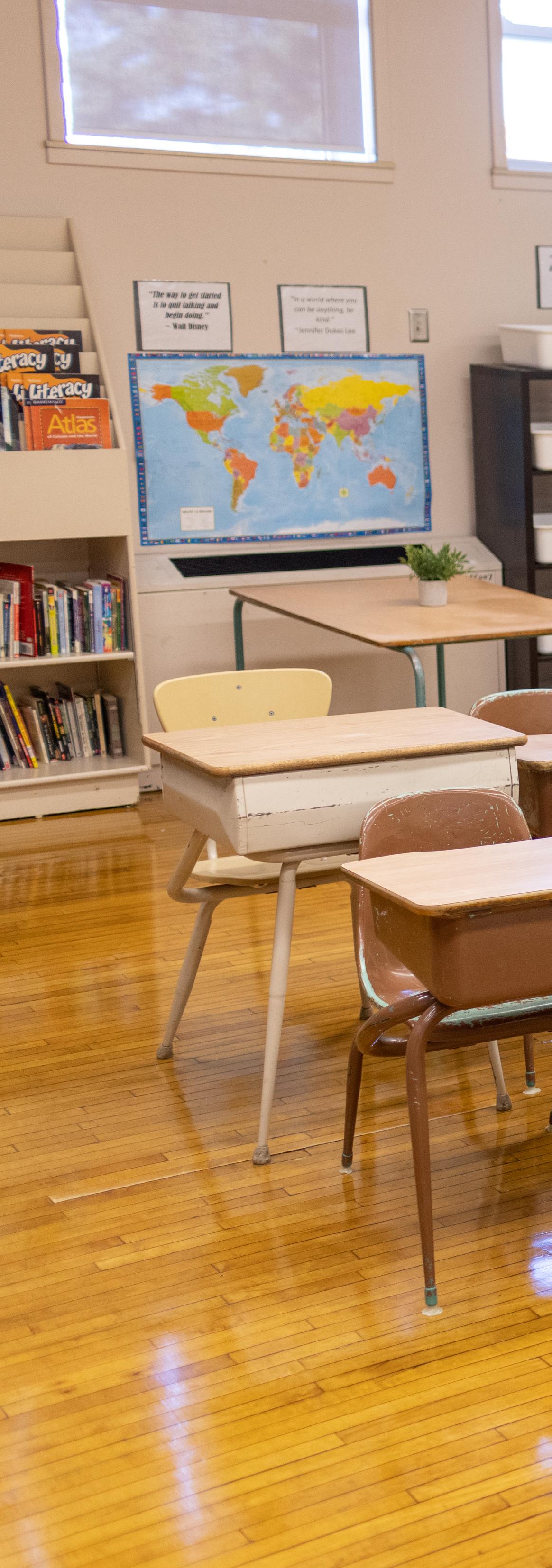
Most research has focused on academic achievement, but there is no consensus on how to organize the school day or school year to ensure it. Studies have instead found contradictory academic gains or losses associated with the various models and often conclude with opposing recommendations.

Meanwhile, there is some consistency in how the variations impact different types of students. Students who perform below standards, in non suburban settings, or with lower socio economic status often benefit more from an expanded school day and enriched summer programs, and are disproportionately disadvantaged by block scheduling. Rural students also spend much more time on the bus, which makes a four day week a serious consideration even when there is little evidence of increased academic success with the model and several risks associated with it. However, while one study found that disadvantaged adolescents benefit from late start times, another found that only suburban adolescents experience positive effects.
When teachers were interviewed, studies found that, overall, teachers prefer more time away from school
(e.g., the four (e.g., the balanced school day that has longer breaks between periods), and year teachers who value the mission behind an alternate school day or calendar (e.g., the expanded school day) also express high work satisfaction.
During the Saskatchewan Teachers’ Federation’s 1995 Symposium on the Alternate School Year/School Day, Federation members articulated the importance of a collaborative decision that teachers should be intensely involved in the process from the beginning. STF Policy 3.2 (School Year and School Day) lists teachers’ beliefs about the school year and day and is undergoing review by Saskatchewan teachers this year. Teachers will be invited to consider how the context around this topic has changed since the policy was last revised and how to ensure school calendars respect the needs of the entire school community.
... many schools have tried variations on the traditional school year and school day, including extended school day, block scheduling, a later start time, or year-long schooling.
20
THE CHANGING FACE OF
Studies of alternate school year/day in Saskatchewan


SASKATCHEWAN IS NO STRANGER TO THE ALTERNATE SCHOOL DAY AND SCHOOL YEAR AND THERE IS RESEARCH TO BACK UP THE EFFECTS.


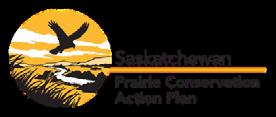

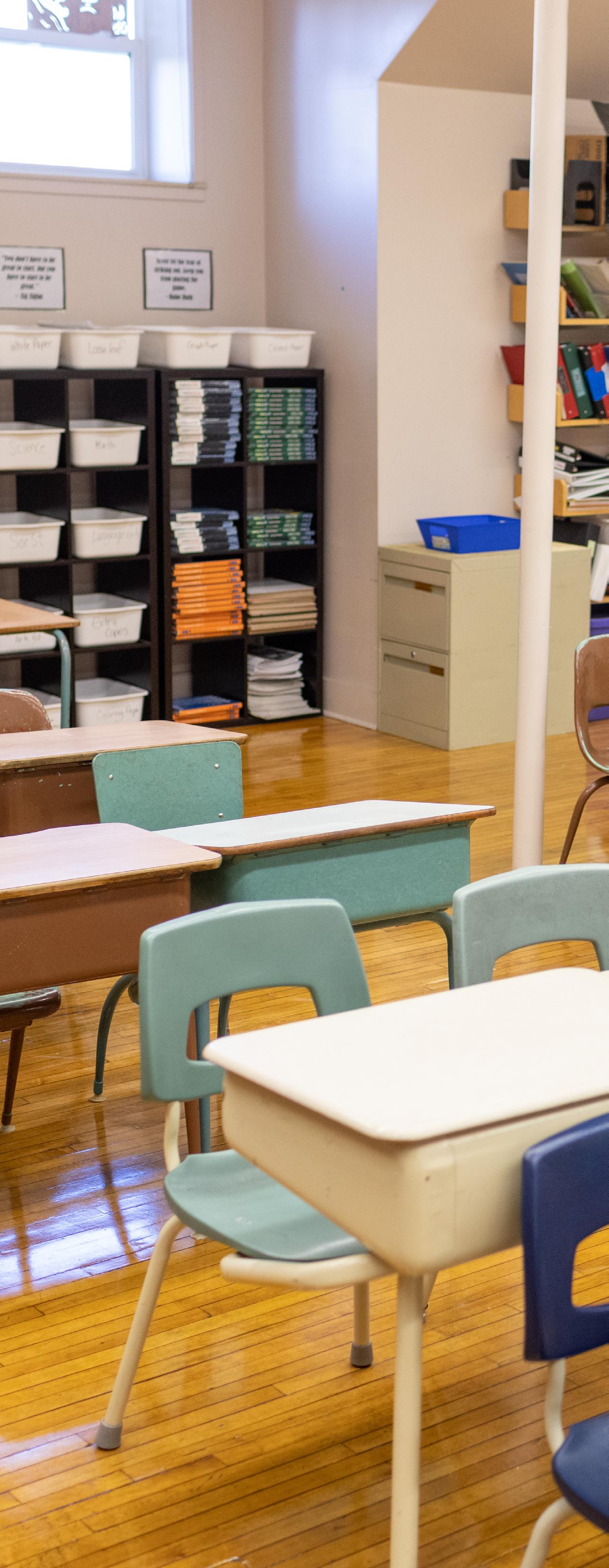
COVID-19: During the COVID 19 pandemic, provincial health orders resulted in an unpredictable school calendar and setting. According to a collaborative study published by the Saskatchewan Population Health and Evaluation Research Unit (Muhajarine et al, 2022), students who needed mental health help were more likely to have been home schooled or done online schooling at home in 2021 22. In addition, students who needed mental health help felt that their schooling had been a lot different and that the changes in schooling had been mostly negative.
Year-Round Schooling: A thesis from the University of Saskatchewan (Anton, 1995) showed that Saskatchewan students who attended year round school had improved time on task and that school internal stakeholders support the year round model.



Four-Day School Week: Prairie South School Division implemented a four day school week to decrease time students spend on the bus and Prairie Valley School Division studied the effect of four on its schools with the support of the Saskatchewan Educational Leadership Unit (Sackney & Kutysuruba, 2008). After measuring a variety of metrics, the Prairie South study recommended that schools revert back to the traditional calendar.
Successfully Changing the School Calendar: Saskatchewan Educational Leadership Unit (1999) examined schools in Western Canada that had alternate school calendars, including E. D. Feehan Catholic High School in Saskatoon for its year (balanced) school year and Grenfell Elementary Community School in Grenfell, Saskatchewan, for its four day school week. It highlighted the importance of including school stakeholders in the planning an implementation of the change, considering the local context, and ensuring alignment with teacher instructional practices.
THE CHANGING FACE OF EDUCATION
Grade 6 Diversity of Life Grade 7 Interactions with Ecosystems Grade 8 Water Systems on Earth Teacher resource kit Classroom presentation Small Group Project Class Project to "Take Action for Prairie" Compatible with the curriculums : Program includes: Contact Education Coordinator, Shirley Bartz : pcap education@gmail com 306 450 1216 www.pcap sk.org mental Programs mental Programs This free program includes a tour of a ranch! Supports learning objectives in the Sustainability of Ecosystems Unit. Grade 10 students analyze a ranch ecosystem in a case study, by using the student guide, online resources and communicating with the rancher. It's Not Too Late to Sign Up For FREE PROGRAMSThis Year! Répertoire complet à FRÉSK.ca Services DJ et animateur d événement Guides pédagogiques F R É S K e s t u n r é p e r t o i r e d e r e s s o u r c e s e t d e s e r v i c e s é d u c a t i f s d e l a c o m m u n a u t é f r a n s a s k o i s e p o u r l e d é v e l o p p e m e n t c u l t u r e l , i d e n t i t a i r e , l i n g u i s t i q u e e t s o c i a l d e s é l è v e s f r a n c o p h o n e s e n S a s k a t c h e w a n Trousses pédagogiques Activités en ligne et en présentiel Réservations : FRESK.CA info@fresk.ca 21
The Makings of a Provincial Budget
 BY STAFF WRITER
BY STAFF WRITER
While so much of teachers’ work is determined by the provincial budget, the process of how that budget gets built isn’t something many teachers spend a lot of time thinking about. As the voice of teachers in Saskatchewan, it is a process the Saskatchewan Teachers’ Federation pays close attention to. In order to influence the budget and lobby on behalf of teachers and public education, the opportunity to influence requires the right timing (if decisions have already been made, there is no opportunity to influence them) and an understanding of the fiscal priorities and pressures that are competing for public funds.
Here’s a quick primer on how the province’s budget is created and approved.
The Treasury Board is a cabinet committee like no other. Made of cabinet ministers and backbench MLAs, its members are appointed directly by the Premier and made
official through an Order in Council. Its mandate is detailed in The Financial Administration Act, 1993, unlike other committees whose work may be more ad hoc. Given its mandate and responsibility for the province’s purse strings, the decisions made by the Treasury Board impact every government priority, program and service.
TREASURY BOARD MEMBERSHIP
Hon. Donna Harpauer, Chairperson
Hon. Jeremy Harrison, Vice Chairperson
Hon. Don McMorris
Hon. Dana Skoropad
Hon. Tim McLeod, MLA
Ken Francis, MLA Alana Ross, MLA
22
SUMMER
Ministry staff begins building the budget by reviewing existing budgets and government commitments. They also examine economic forecasts from the chartered banks and forecasts for this, such as oil, natural gas and potash – the natural resources that drive provincial revenues – to understand how much money they have to spend.
EARLY FALL
The Treasury Board issues a call to all government ministries, including education, to submit their estimates. The call for estimates usually includes a “spending target,” which is how much each ministry is being asked to increase or decrease their overall budget.
NOVEMBER – DECEMBER
All government ministries submit their proposed budget to the Treasury Board. The Board often asks ministers to find additional opportunities to cut spending and puts additional pressure on ministers to successfully justify their spending requests.
As a result, the overall framework for the budget is usually set by the end of the calendar year.

JANUARY – FEBRUARY
Cabinet finalizes and approves the budget. A few weeks later, government caucus finalizes the budget. While it is rare for the budget to change based on caucus feedback at this time, government members must be prepared to address the budget and support the decisions made when speaking to stakeholders, including constituents.
MARCH
The provincial budget is tabled in the legislature. It is then debated and typically passed in May.
Each minister invites key stakeholders to attend the tabling of the budget. At the invitation of the Minister of Education, the Federation’s President is invited to budget day at the legislature. Being present provides an important opportunity to connect with other stakeholders and provide the Federation’s reaction to the budget to reporters.
Based on the provincial budget, each school division is required to submit a budget, which is then reviewed and must be approved by the Ministry of Education.
23
in 2023
Teacher Wishes for Students
To kick off the new year, we asked teachers from across the province to share their hopes and dreams for Saskatchewan students in 2023. Here are some of the wishes they shared.

RANDY JOHNSON, EASTEND, CHINOOK TEACHERS’ ASSOCIATION
I hope they can all be kids again. They’ve been tied up in red tape from a lot of adult discussions and decisions. It’s time for them to be kids again.
DANIEL DION, REGINA, ASSOCIATION LOCALE DES ENSEIGNANTES ET ENSEIGNANTS FRANSASKOIS
Je souhaite que les élèves puissent retrouver au sein de leurs communautés scolaires les appuis nécessaires afin qu'ils puissent s'épanouir et être valorisés.


I wish that all students find, within their school communities, all the necessary supports that will allow them to thrive and be valued.
JOSHUA MCINTOSH, SANDY BAY, NORTHERN AREA TEACHERS’ ASSOCIATION
Living up North, we have a lot of challenges. Our students face incredible challenges with food insecurities and clothing. I wish kids could go to school and not have to worry about anything, including about feeling safe and secure.
KATE DAY, SASKATOON, SASKATOON TEACHERS’ ASSOCIATION
I wish for a sense of belonging, peace and safety.

LENNI ZANIDEAN, SWIFT CURRENT, HOLY TRINITY TEACHERS’ ASSOCIATION
I want them to be social and take part in school dances and assemblies, to have guests and parents in our schools, have lunches and all the excitement and fun they used to have pre COVID.
ANGELA RANCOURT WITH TRANSLATIONS FROM ELDER SOPHIE MCDOUGALL, ST. LOUIS, PRINCE ALBERT AND AREA
TEACHERS’ ASSOCIATION
May vue say chtu kellay pluu lay aytude a lii tayr, lii rivyayr, lii maymairs, lii vyeu, lii riir, ay ton spirii communitay. Jai ferr avek day shoose ketchu va troovay ketchu a la rayponse day priayr de noos aansaytres.


My wish is that you have more learning from the land, the rivers, the grandmothers, the Elders, the laughter, and the community. I hope that through these things you will find that you are the answered prayer of your ancestors.
ANTHONY STOFFEL, REGINA, REGINA PUBLIC SCHOOLS TEACHERS’ ASSOCIATION
A lot of our classrooms are fully loaded with 28 to 30 kids. We have great staff and truly great kids, but when you have so many together, it’s difficult to get around. An extra teacher or two would help separate the students a bit so we can give them the education they deserve.
COLLECTIVE WISDOM 24
PETE CHIEF, SASKATOON, SASKATOON TEACHERS’ ASSOCIATION
ka miyawsin metawew kamik ko osihta awasisak ohci. mina nehiyawicikewinikamihk kotahk kaya ita awasisak ta kiskeytakihk awiyna oma wiyawaw.
It would be nice to have a prekindergarten playground for our little ones, as well as having a Cree culture classroom where our students can learn about who they are.
AMY HIRON, LLOYDMINSTER, LLOYDMINSTER TEACHERS’ ASSOCIATION
I wish they would see themselves the way I see them –amazing, funny, intelligent and worthy. Teenagers are the best.
SHELLY RIFFEL, REGINA, SUPERANNUATED TEACHERS OF SASKATCHEWAN
I wish for increased funding for publicly funded education with class sizes of no more than 20 students, no triple grades, outdoor learning spaces and counsellors in the building, as needed.
KARIELLE WILLNER, DAVIDSON, SUN WEST TEACHERS’ ASSOCIATION
I hope that everything they hope their year will look like is exactly what it looks like. If they want to be involved in a volleyball program, they can do that. If they want to be in band, they have that opportunity.
From several hundred members initially, the STS has grown to over 12,000 in 41 Chapters spread across Saskatchewan and British Columbia. We are also the largest local of the STF.
A key reason to join the STS is the financial security provided by our Group Benefits program, funded wholly by superannuates. Our plan has over 8,800 members which allows us to offer coverages at competitive rates that would be difficult to obtain as an individual. One of the most significant components is out of country travel coverage.
As professionals we care about our students and colleagues. Well being in its many forms is something we still value. Provincially and at the Chapter level, there are many opportunities to engage with colleagues in social and recreational
activities. For those who wish to engage a bit more, there are positions on executives at both levels. We continue to support public education and advocate for initiatives that support older adults as valued members of society.


Membership is voluntary. In addition to taking part in the separate STF and STS retirement information sessions, please touch base with us if you need more information. We would love to have you as part of the STS family.
Please check our website at sts.sk.ca for more information.

COLLECTIVE WISDOM
2023 marks the 50th anniversary of the formation of the Superannuated Teachers of Saskatchewan. A key motivation was the desire to improve the lives of retired educators, at a time when pensions were as little as $100 a month, without a cost-of-living adjustment!
25
MEET YOUR LOCAL LEADERS
Local associations provide teachers with a collective voice at the local level and, through their executive and councillors, a central connection with the provincial organization. Elected local association presidents play an integral role in sharing members’ voices and representing their needs.




STUART WILSON

MELVILLE COMPREHENSIVE, GOOD SPIRIT TEACHERS’ ASSOCIATION
Stuart Wilson is originally from the hamlet of McCord, Saskatchewan and currently resides in Melville, where he teaches at Melville Comprehensive School. Wilson got involved in his local association when there was a need for a new Saskatchewan Teachers’ Federation councillor.

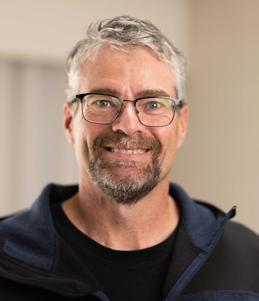
When asked about who inspired him to join the teaching profession, Wilson shares, “my grandmother and mother were both teachers, but the majority of my inspiration came from my own love for learning. I wanted to instil a love of learning in the students I teach.”
When he’s not teaching, you can find Wilson trail running. He completed his first ultramarathon this year!
JAMES STONE
CUT KNIFE COMMUNITY SCHOOL, TRI-WEST TEACHERS’ ASSOCIATION
James Stone has lived all over Canada and even spent time living in Japan –but now he’s settled into his 14th year of teaching. He teaches at Cut Knife Community School.
Stone was inspired to join the teaching profession by Mr. Nagai while working as an assistant English teacher in Japan.
“I discovered I loved sharing learning, knowledge and time with the kids,” he says.
When asked about what gives him hope when working with students today, Stone says, “their energy, their enthusiasm and seeing just how capable they already are, right from the moment they step into the school. We just nudge them along.”
JOHN MCGETTIGAN
SASKATOON TEACHERS’ ASSOCIATION



John McGettigan was born and raised in Saskatoon, Saskatchewan – where he is now President of the Saskatoon Teachers’ Association.
John got involved in the STA when he asked a former Vice President of the Association to help with an issue with a colleague. The Vice President and the Association responded with kindness, which inspired him to get involved.
The inspiration to join the profession was his father who became a physician. His father often credited his teachers for making that happen – and McGettigan wanted to be a part of someone’s future too.
When asked about his claim to fame, McGettigan says, “well… what’s safe to publish?! I was a North American champion Irish dancer as a young person and loved every second of it.”
LORRIE FIECHTER
HOLY FAMILY TEACHERS’ ASSOCIATION
Lorrie Fiechter has always had amazing teachers in her life, so it’s no surprise she was inspired to join the profession. Born and raised in Ceylon, Saskatchewan, Fiechter’s love for teaching was evident from an early age. Every year growing up, she would teach skating and swimming programs. She says, “just being with children and youth made my decision to enter the profession a very easy and rewarding one.”
Fiechter is an advocate for learning and wellness, believing learning will only take place effectively when there is a healthy balance between wellness and knowledge exchange. “I have hope that tomorrow will be better. That all the mental health issues and gaps in our students’ learning will be met.”
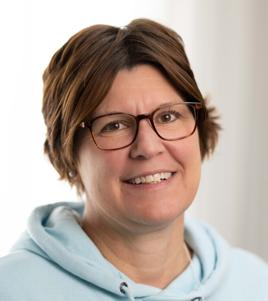
26
Where action research meets impact.
Graduate programming at the new Jane and Ron Graham Centre for the Scholarship of Teaching and Learning is tailored to those interested in examining novel teaching approaches that lead to improvements in student learning and educational quality.


The Scholarship of Teaching and Learning (SoTL) is an emerging movement of scholarly inquiry that focuses on the reciprocal relationship between teaching and learning. The purpose of SoTL research is to improve learning by investigating the many features of discipline-specific expertise and best pedagogical practice, and making the results public.
Master of the Scholarship of Teaching and Learning
• Thesis-based online program, with four required courses and three elective courses at the graduate level
• Full or part-time options
• Possible completion in two years
Certificate in the Scholarship of Teaching and Learning


• Four online courses: Fall (SOTL 801 & 802), Winter (SOTL 803), Spring (SOTL 804)
• Typically taken over one year
• May be used toward completion of the M.SoTL
education.usask.ca/grahamcentreSoTL
Foster curiosity, critical thinking skills and empathy by learning about Saskatchewan’s diverse histories through WDM exhibits, artifacts, archival material, inquiry-based learning opportunities and hands-on experiences.
For information on visiting a WDM, in-Museum school programs, teacher-led experiences, virtual programs, resources for your classroom and an opportunity to win a free field trip to the WDM visit wdm.ca/education
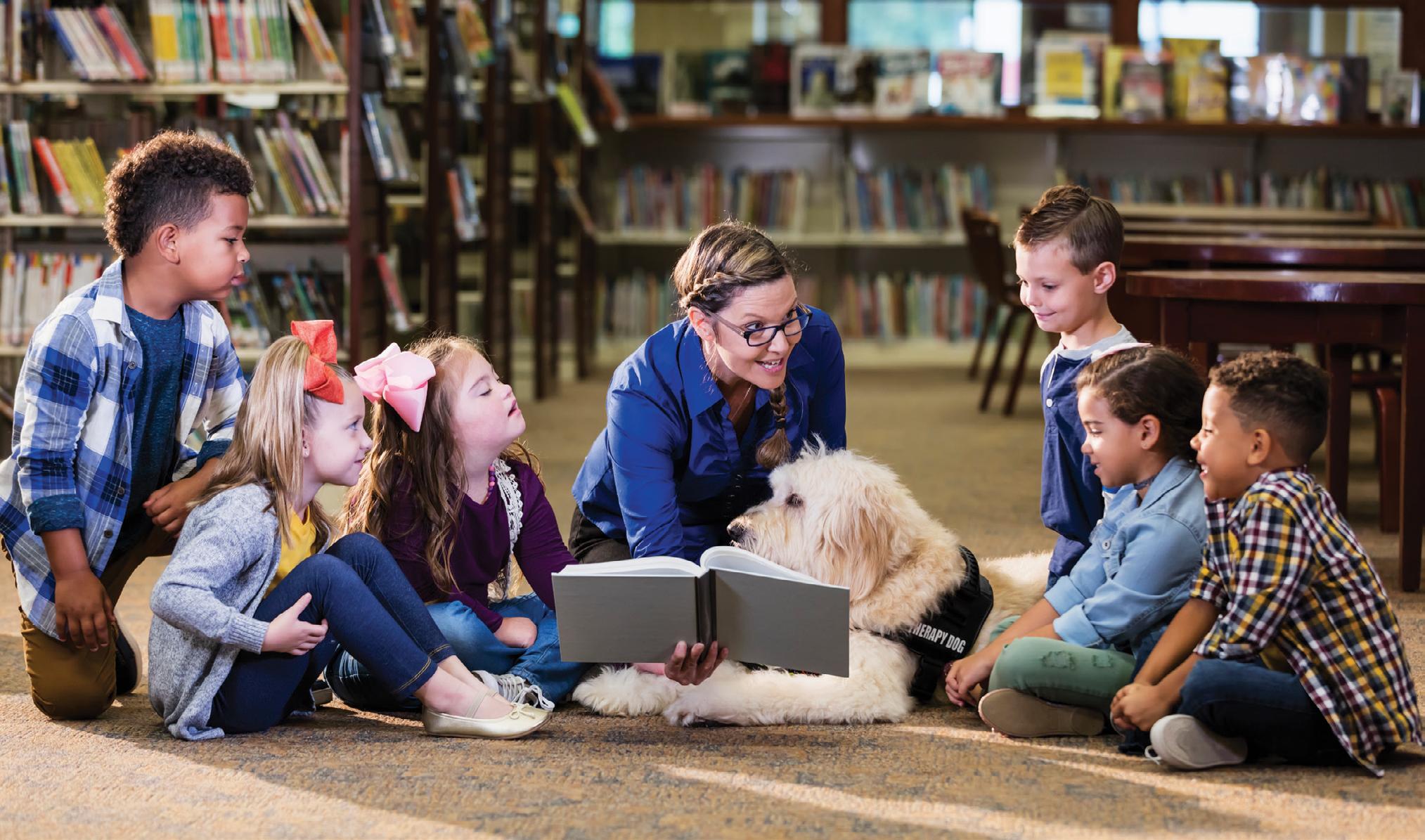
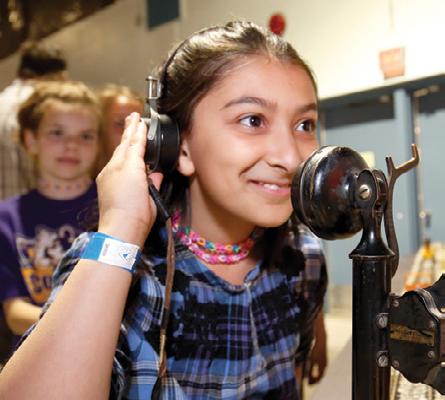
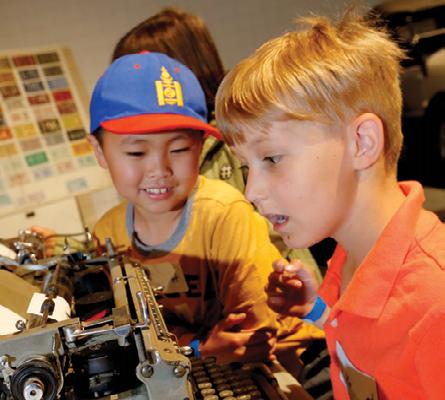
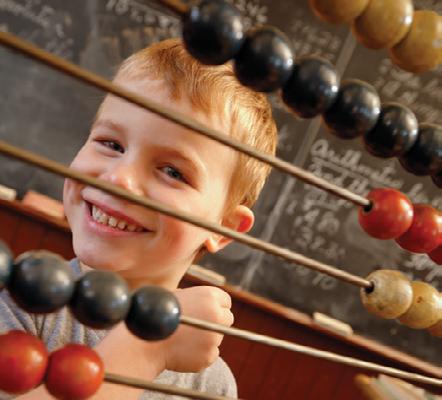
How do we know what really happened in the past?
How does history shape our present-day realities?
EVERYONE
What is history?
CERTIFICATE OF EXTENDED STUDIES IN INCLUSIVE EDUCATION I’M MAKING A DIFFERENCE. 28
MOOSE JAW NORTH BATTLEFORD SASKATOON YORKTON WDM.CA
A SASKATCHEWAN WHERE
BELONGS AND HISTORIES MATTER
The Saskatchewan Ministry of Education provides incentives to earn this certificate. KNOWMOREDOMORE.CA
Record Enrolment in Saskatchewan Schools
BY STAFF WRITER
A record number of students are in Saskatchewan classrooms. In November, the Minister of Education announced an additional $15 million to address this enrolment. In response, Saskatchewan Teachers’ Federation President Samantha Becotte stated, “this funding is the bare minimum of what divisions require to address the additional number of students in our schools, but it won’t provide the additional supports students need to ensure their success.”
The statements of record spending in education is accurate, but shouldn’t be confused for adequate investment. As Becotte has accurately compared it, “just because I spent more at the grocery store, doesn’t mean my cart has more groceries in it.”
The additional funding for education amounts to just $82 per student and does not address the lack of resources and supports for students due to years of chronic underfunding. Teachers, principals and other professionals in the education system continue to use the word “triage” to describe the current state. Sustainable, predictable and adequate funding is needed to ensure all Saskatchewan students receive the education they deserve.
Inflation, Interest Rates Continue to Rise
BY STAFF WRITER
Inflation and interest rates continue to rise and will continue to put financial pressure on households. In August, Saskatchewan’s rate of inflation was slightly below the national average, but has since climbed back up. September was 7.1 percent, above the national average of 6.9 percent; and October was 8.0 percent, above the national average of 6.99 percent.
STF Chief Investment Officer Alison Gould says for most of 2023, “additional rate increases are expected, as well as an economic slow down and some level of recession. Once the Bank of Canada and the US Federal Reserve [System] contain inflation, then interest rates will be moved lower to get the economy moving again. This will likely happen toward the end of 2023.”
RESOLUTIONS
Resolutions to Council may be submitted by any member. Additional information, as well as the submission form, is available when logged in to MySTF at www.stf.sk.ca/about-stf/our-team/ council/resolutions-notices-motion. The deadline for submissions is noon on Friday, February 3, 2023.
ELECTION DEADLINE
Councillors seeking election to the 2023-25 Executive of the Federation may announce their candidacy in the 2023 Elections and Candidate Statements Information booklet. For more information, access the Nomination and Candidate’s Declaration form when logged in to MySTF at www.stf.sk.ca/resource/nomination-andcandidates-declaration-form.
#SUM2023 May 4 & 5, 2023 REGISTER AT SMTS . CA KEYNOTE PRESENTERS Geoff Krall Author of Necessary Conditions: Teaching Secondary Math with Academic Safety, Quality Tasks, and Effective Facilitation Nat Banting Winner of Prime Minister’s Award for Teaching Excellence in STEM Hema Khodai Advocate for Anti-Oppressive and Anti-Racist Mathematics Education Pre-Conference Workshop with Geoff Krall May 4, 2023 | 9:00 a.m. - 3:30 p.m. | STF Building | $150 SUM Conference May 4 and 5, 2023 | Delta Hotel, Saskatoon SK | $200 Opening Keynote on May 4 | 7:00 p.m. - 8:30 p.m. Keynotes/Break Out Sessions on May 5 | 9:00 a.m. - 3:30 p.m. 29
Advice for Navigating Device Use and Privacy Protection
 BY STAFF WRITER
BY STAFF WRITER
The use of devices and privacy protection is a balancing act that all principals, vice-principals and assistant principals inevitably navigate daily. In these roles, you are expected to communicate with staff, students and families, and often use your personal device to do so.

Here are some tips for how to ensure you protect yourself and data while using a personal device for professional purposes.
1 KNOW WHERE YOUR DATA GOES (DATA PRIVACY).
This encompasses all information communicated through your device. Most people’s devices will be set up to automatically back up to the cloud. Check your privacy settings and decide which information to share – or not to share – to the cloud. Do you have data being synced across multiple devices? You can coordinate your settings so they remain the same across devices. Also consider what social media platforms you may be connected to and understand what access they have to information shared on your device.
2 KNOW THE RULES AND THE TOOLS.
Use division approved communication tools, such as Edsby and Seesaw, to communicate with parents rather than texting. What are the administrative procedures or policies your school division has in place for device use? Follow and communicate these procedures or policies with your staff and be sure to review them with your teams annually. Does your school have tools available to you to protect your privacy if you’re using a personal device? For example, an app that allows you to communicate with students and families without revealing your personal number may be one tool available to you.
3 USE OF A PERSONAL DEVICE MEANS PERSONAL COMMUNICATION.
If using your personal device, any conversation you have with a student and others is a personal one and that communication may not be employer sanctioned. These conversations won’t be recorded or backed up with your employer the way email is. Treat it as such and ensure you have parameters established in line with your administrative procedures or policies for what and how you are communicating.
PRINCIPALS’ NOTES
30
4 KEEP IT FACTUAL.
If you are using text messages, stick to the facts and don’t share personal information about students or staff. When communicating information to colleagues or families about students, use texting to set up a phone call or meeting to further discuss student learning outcomes, address behaviour, or communicate other information where privacy may be at risk.

SET AND RESPECT BOUNDARIES.
5
This goes for you and for your team. If you are using a personal device, this can be even more challenging. Set your boundaries when it comes to after hours communication and do not expect others to respond just because you are working during these hours.
MODEL GOOD PRACTICE AS A LEADER.
6
Set the standard for yourself and your teams by role modelling best practices when it comes to personal device use in your school. Be clear about your expectations and the procedures or policies in place everyone must follow when communicating with their school community, whether it be through a personal device or one provided by or compensated for by your division.
Are you ready for something more in your professional life?
Are you looking for a larger, more global view of education?
As a teacher, do you feel you have more to offer and more to learn?
Are you ready for a personal and professional adventure?
IF YES, VOLUNTEER FOR PROJECT OVERSEAS WITH THE CANADIAN TEACHERS’ FEDERATION AND THE SASKATCHEWAN TEACHERS’ FEDERATION.
The CTF and STF are seeking an English- and/or French-speaking teacher at the elementary and secondary levels who is interested in volunteering their time and talents to offer professional development in-service programs in partnership with teacher organizations in developing countries. Each year, over 50 Canadian teachers are chosen to volunteer on Project Overseas in countries throughout Africa and the Caribbean. The Project Overseas in-service projects take place in July.
Please visit the Professional Resources section of our website, www.stf.sk.ca, for further information and application forms, or contact us at stf@stf.sk.ca.
Deadline for applications is December 19, 2022.

31
STF member experiences, opinions and expertise are required to ensure member interests and priorities are heard in the next round of provincial collective bargaining.
WINTER 2023
School Staff Liaison Engagement Sessions: Virtual
January 23-February 17
Town Hall Meetings: Virtual Visit the Events Calendar for details and to register.
Focus Groups
Various dates. Members will be recruited directly.
Town Hall Meetings: In Person
January 31, North Battleford, Meadow Lake
February 1, Lloydminster
February 7, Regina, Saskatoon, Prince Albert
February 8, Weyburn, Swift Current, Yorkton
For more information and to register for upcoming member feedback events, please visit www.stf.sk.ca > Teaching in Saskatchewan > Collective Bargaining
stf-001215a / 20221128 PUBLICATIONS MAIL AGREEMENT # 40064493 RETURN UNDELIVERABLE CANADIAN ADDRESSES TO: SASKATCHEWAN TEACHERS’ FEDERATION 2317
Arlington Avenue Saskatoon SK S7J 2H8 Tel: 306 373 1660/1 800 667 7762 Fax: 306 374 1122
MEMBER FEEDBACK EVENTS
PROVINCIAL COLLECTIVE BARGAINING 2023 connect with us
HAVE YOUR SAY
@SaskTeachersFed www.stf.sk.ca
SPRING 2023 Annual Meeting of Council April 26-29 Approved Proposals May 1





















 BY STAFF WRITER
BY STAFF WRITER







 BY STAFF WRITER
BY STAFF WRITER



 BY STAFF WRITER
BY STAFF WRITER
























 BY STAFF WRITER
BY STAFF WRITER





























 BY STAFF WRITER
BY STAFF WRITER


